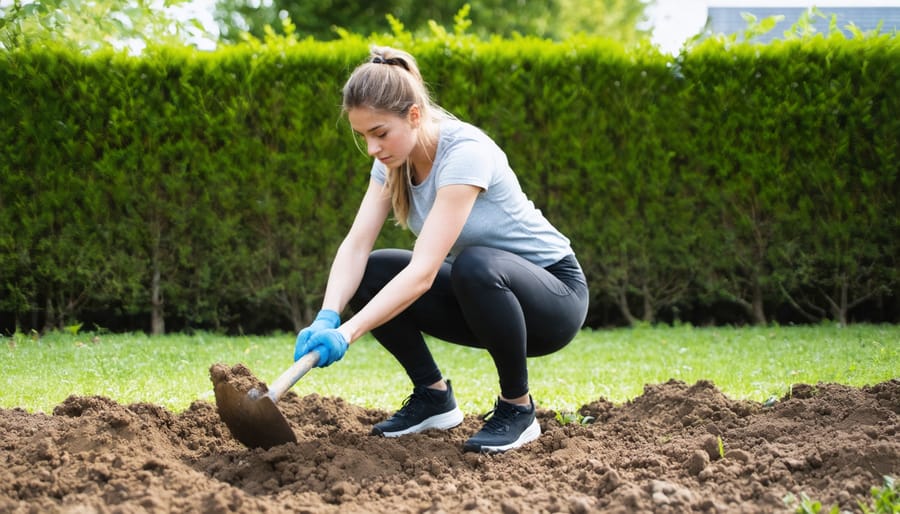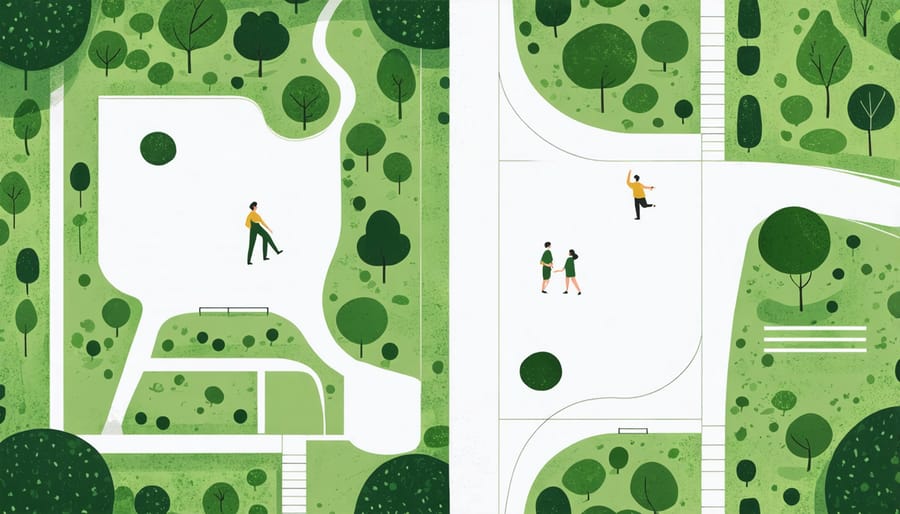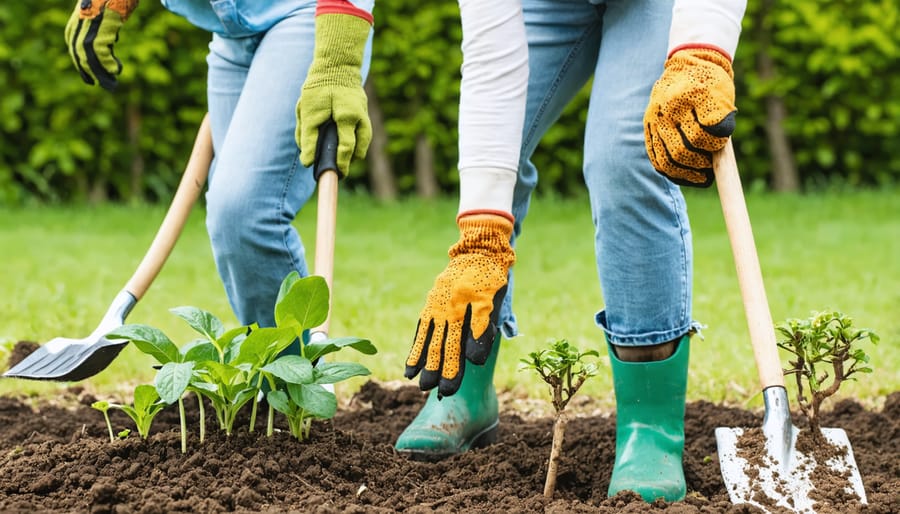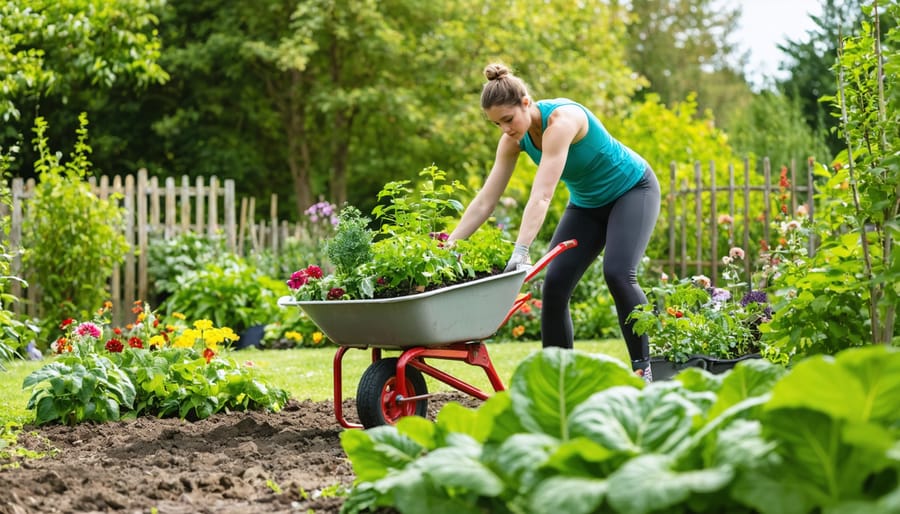Transform your garden into a natural fitness studio by combining traditional gardening tasks with purposeful movement patterns. Pushing a manual mower across uneven terrain engages core muscles and builds cardiovascular endurance, while digging and weeding in deep squat positions strengthens legs and improves flexibility. The gentle resistance of pulling weeds, turning compost, and moving soil works multiple muscle groups simultaneously – all while accomplishing essential garden maintenance.
Beyond the physical benefits, outdoor activity in your garden reduces stress hormones and increases vitamin D production through natural sunlight exposure. Studies show that gardeners who intentionally incorporate exercise movements into their routine burn up to 400 calories per hour, comparable to moderate gym workouts. The varied movements required for garden maintenance – reaching, bending, lifting, and stretching – create a full-body workout that improves balance, coordination, and functional strength.
Whether you’re maintaining a small herb garden or tending to sprawling vegetable beds, every gardening task presents an opportunity for mindful movement and health enhancement. By approaching garden work with deliberate attention to form and engaging core muscles throughout each activity, you’ll cultivate both a thriving garden and improved physical fitness.
Why Your Garden is the Perfect Outdoor Gym
Natural Resistance Training
Gardening naturally incorporates many natural movements that build strength without the need for traditional gym equipment. When you dig, lift, and carry garden materials, you’re engaging in resistance training that targets multiple muscle groups. Wheelbarrow loads of compost or mulch become your free weights, while spading garden beds works your core and upper body much like a rowing machine would.
Common gardening tasks provide excellent strength-building opportunities. Pulling weeds engages your arms and core muscles, while moving rocks for landscaping projects works your legs and back. Even seemingly simple activities like pruning overhead branches or maintaining hedges provide an upper-body workout comparable to resistance band exercises.
The beauty of garden-based strength training lies in its functionality. Instead of isolated exercises, you’re performing compound movements that mirror real-life activities. This practical approach to fitness not only helps maintain your garden but also builds functional strength that serves you in daily life. Remember to alternate between heavy and light tasks, giving your muscles time to recover while keeping your garden thriving.
Cardio in the Garden
Gardening isn’t just about nurturing plants – it’s a fantastic way to get your heart pumping! Many common gardening tasks naturally elevate your heart rate, turning your garden into an outdoor gym. Digging, weeding, and pushing a loaded wheelbarrow are particularly effective cardio activities that can burn between 200-400 calories per hour.
To maximize cardiovascular benefits, try alternating between high-intensity tasks like vigorous digging and lighter activities such as pruning. Maintain a steady pace while raking leaves or hoeing soil, and you’ll notice your breathing become deeper and more rhythmic. For an extra cardio boost, try speed weeding – set a timer for 10 minutes and see how many weeds you can pull!
Remember to move continuously between garden beds rather than staying in one spot. Walking back and forth with tools and materials, squatting to plant seedlings, and reaching to prune high branches all contribute to raising your heart rate. The beauty of garden cardio is that you’re so focused on your plants, you hardly notice you’re exercising!
Make sure to warm up with gentle stretching before tackling more strenuous tasks, and stay hydrated throughout your garden workout. Your heart – and your garden – will thank you for the attention!
Garden Fitness Zones: Design for Movement
Strategic Layout Planning
Creating a garden layout that encourages physical activity starts with thoughtful planning and an understanding of biophilic garden design. Begin by mapping out zones that naturally flow into one another, creating pathways that invite exploration and movement. Consider incorporating different levels and terraces that require climbing steps or gentle slopes, which naturally increases your heart rate as you move through the space.
Position your most-visited areas, such as herb gardens or vegetable patches, at varying distances from your home. This strategic placement ensures you’ll need to walk further to tend to different garden sections. Create dedicated workout spaces by leaving open areas near trees for stretching or yoga, and install sturdy structures like pergolas that can double as support for body-weight exercises.
Include features that require regular maintenance at different heights – from ground-cover plants that need frequent weeding to vertical gardens that encourage reaching and stretching. Place your compost bin and tool shed at opposite ends of the garden to increase natural movement during everyday tasks. Remember to incorporate resting spots strategically throughout the space, allowing for interval-style activity as you work.
Design wide, curved paths rather than straight ones to make walking more engaging and to accommodate wheelbarrows and garden carts. This thoughtful layout not only enhances the garden’s aesthetic appeal but also turns routine maintenance into an opportunity for consistent physical activity.

Adding Fitness Elements
Transform your garden into a dynamic fitness zone by strategically incorporating exercise areas that blend seamlessly with your outdoor space. Start by creating a dedicated stretching area using weather-resistant rubber mats placed on level ground, perhaps beneath a shade tree or pergola. This space can serve double duty as a yoga spot during early morning gardening sessions.
Install simple fitness stations along your garden paths. Weather-treated wooden posts can become perfect support for bodyweight exercises like push-ups or stretches. Consider adding stepping stones in varying distances to create a natural circuit training path that challenges balance and coordination while moving between garden beds.
Utilize existing structures creatively – a sturdy garden fence can double as a support for wall push-ups or stretches, while raised beds with reinforced edges make excellent platforms for step-ups and balance exercises. Install a pull-up bar between two solid posts, ensuring it’s positioned at a height that works for you and is safely secured.
Create a natural obstacle course using logs, large stones, or recycled materials. Position these elements thoughtfully so they serve both as garden features and fitness challenges. A winding path through your vegetable garden can become an agility course, while a meditation corner with comfortable seating provides a perfect cool-down spot after your garden workout.
Remember to choose weather-resistant materials and regularly check all fitness elements for stability and safety. The key is integrating these features naturally so they enhance rather than detract from your garden’s aesthetic appeal.

Garden Workouts That Actually Work
Lower Body Strengthening
Gardening naturally provides excellent opportunities for strengthening your lower body, and with a few mindful adjustments, you can maximize these benefits. Simple activities like squatting to pull weeds or deadhead flowers engage your quadriceps, hamstrings, and glutes. When you’re working at ground level, try alternating between squats and lunges as you move along your garden beds – this variation helps target different muscle groups while getting your tasks done.
Walking through your garden while pushing a loaded wheelbarrow is another fantastic way to strengthen your legs and core. The uneven terrain of garden paths provides natural resistance training, and the added weight helps build muscle. When lifting heavy pots or bags of soil, remember to use your legs rather than your back, turning these necessary tasks into perfect squat exercises.
Creating level ground for new garden beds offers an excellent workout too. The repetitive motion of tamping down soil engages your core and legs, while stepping on a spade uses similar muscles to a step exercise. Even tasks like mulching become more beneficial when you focus on proper form: keep your core engaged and take deliberate steps as you spread materials.
For added intensity, try walking lunges while carrying your watering can from plant to plant, or practice calf raises while reaching for higher branches during pruning sessions. Remember to switch sides regularly to maintain balance in your workout.
Upper Body Toning
Gardening offers numerous opportunities to strengthen your upper body while tending to your outdoor sanctuary. Simple tasks like pruning overhead branches and maintaining hedges engage your shoulders and arms in ways similar to traditional gym exercises. When pulling weeds, try maintaining proper form by keeping your back straight and using your arm strength rather than just your hands.
Digging and turning compost are excellent ways to work your biceps and triceps. Hold your spade or fork with both hands and engage your core as you lift and turn the soil. This movement mimics the action of a rowing machine, providing a comprehensive upper body workout. When moving bags of soil or mulch, treat them as you would weights at the gym – lift with proper form and use controlled movements.
Creating raised beds or building trellises offers another dimension of upper body exercise. The hammering, sawing, and carrying of materials naturally works your shoulders, arms, and chest. Even tasks like pushing a loaded wheelbarrow strengthen your arms and shoulders while improving stability.
For an extra challenge, try maintaining your hedges with manual shears instead of electric ones. The continuous opening and closing motion provides resistance training similar to using hand grips. Remember to switch arms periodically to ensure balanced muscle development and prevent fatigue. Always take breaks when needed and stay hydrated, especially during warmer weather.
Full-Body Movement Patterns
Gardening naturally incorporates many full-body movements that mirror exercises you might do at the gym. When you combine these movements intentionally, you create a comprehensive workout that strengthens multiple muscle groups while accomplishing your garden tasks. For instance, weeding involves squatting and core engagement, similar to a gym squat, while raking leaves works your arms, back, and obliques like a rowing machine.
Try creating movement patterns that flow naturally from one task to another. Start with digging, which engages your legs and core, then move to carrying soil or mulch, which works your arms and back. Follow this with pruning at various heights to include reaching and stretching movements. This combination provides a balanced workout while maintaining your garden’s health.
To maximize the exercise benefits, focus on proper form: keep your back straight when lifting, engage your core during bending movements, and alternate sides when doing repetitive tasks like hoeing or raking. Add variety by incorporating walking lunges between garden beds, doing standing twists while watering, and practicing balance while reaching for high branches.
Remember to move mindfully and listen to your body. The beauty of garden-based exercise is that you can adjust the intensity and duration to match your fitness level while achieving tangible results in your garden.
Safety and Sustainability
Proper Form and Technique
When gardening, proper form is essential to prevent strain and maximize the benefits of your outdoor activity. Start by maintaining a straight back when bending to pull weeds or plant seedlings – hinge at your hips rather than rounding your spine. Keep your core engaged, imagining you’re hugging your belly button toward your spine.
For lifting, always bend your knees and keep heavy objects close to your body. Whether you’re moving bags of soil or relocating potted plants, power through your legs rather than your back. When using tools like rakes or hoes, stand with feet shoulder-width apart and avoid twisting movements – instead, pivot your whole body to change directions.
During repetitive tasks like pruning or harvesting, alternate between your right and left hands to balance the workload. Take regular breaks every 30 minutes to stretch and hydrate. Remember to keep your shoulders relaxed and avoid locking your joints, especially when reaching or digging.
For extended kneeling work, use a garden pad or knee protectors, and periodically shift your weight to prevent stiffness. These simple adjustments will help you garden comfortably and safely while getting a great workout.

Pacing and Recovery
Just like tending to your garden in seasons, outdoor physical activity requires a thoughtful balance between active periods and rest. Start with 15-20 minute sessions, gradually increasing duration as your stamina builds. Listen to your body’s signals and take breaks when needed – perhaps pause to admire your blooming flowers or practice mindful gardening practices between more strenuous tasks.
Alternate between high-effort activities like digging or wheelbarrow pushing and lighter tasks such as pruning or planting. This natural rhythm helps prevent exhaustion and reduces the risk of strain. During hot weather, schedule your garden workout sessions for cooler morning or evening hours, and always keep water nearby.
Remember that recovery is just as important as the activity itself. Give yourself at least one rest day between intensive garden workouts, using this time for gentle stretching or planning your next garden project. This balanced approach ensures you can maintain your outdoor activities throughout the growing season while staying energized and injury-free.
As we’ve explored throughout this article, garden-based fitness offers a unique and rewarding way to stay active while nurturing your outdoor space. The combination of physical movement, fresh air, and the satisfaction of watching your garden flourish creates an unbeatable formula for both mental and physical well-being. From squatting to plant seedlings to pushing wheelbarrows and pruning trees, gardening engages multiple muscle groups while providing a sustainable form of exercise that adapts to your pace and ability.
Remember that every gardening session, no matter how brief, contributes to your overall fitness journey. Start small by incorporating simple stretches into your routine, gradually building up to more demanding tasks as your strength and confidence grow. The beauty of garden-based fitness lies in its accessibility – there’s no need for expensive equipment or gym memberships, just your garden tools and a willingness to get moving.
As the seasons change, so too will your gardening activities, ensuring variety in your workout routine throughout the year. Whether you’re raking leaves in autumn, preparing beds in spring, or harvesting vegetables in summer, each task brings its own physical challenges and rewards.
Take the first step today by choosing one gardening activity to approach with fitness in mind. Your body – and your garden – will thank you for it.




